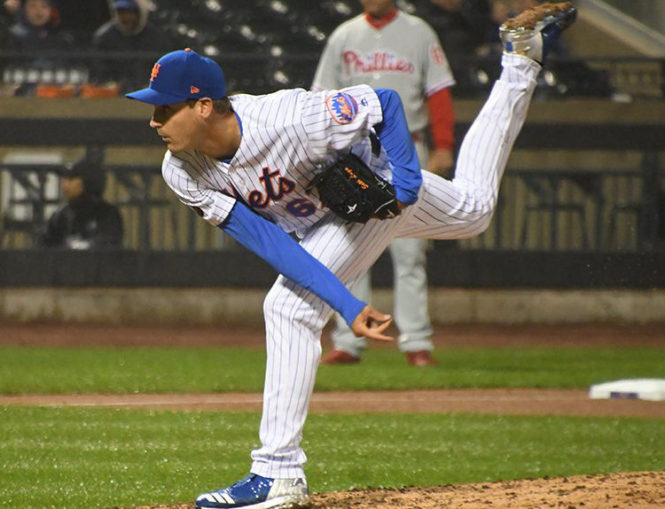
Technology has heavily contributed to our ever-evolving understanding of pitching. The Rapsodo system, in particular, can be attributed for this change, by allowing both players and coaches to maximize a pitcher by observing the physicalities of his pitches.
Kyle Boddy and his company, Driveline, have been at the forefront of the “Rapsodo movement”, continuously releasing articles on how to maximize the effectiveness of certain pitches. Rapsodos, which can found in the bullpens of almost every Major-League club, track, break down, and analyze a pitcher by using slow-motion cameras. By analyzing the data gleaned from a Rapsodo machine, pitchers can be recommended to change their arm slot, boost their spin efficiency, or locate their pitches better.
With technology dictating the future of the pitching landscape, amateur coaches have been forced to rethink their now-outdated adages. One aspect of their lessons they have been forced to change involves the idea that pure velocity isn’t the name of the game anymore. What good is a 100 mph fastball if it’s as straight as a string? Velocity can’t be the only weight to evaluate pitches; the movement, the spin axis, and spin efficiency are only some of the other factors that come into play.
That’s where Pitch Design comes into play.
Using the information provided from the Rapsodo system, Boddy and the rest of the pitching geniuses over at Driveline have created a slew of new metrics that have advanced our understanding behind the physics of pitching. Terms like gyro spin, transverse spin, and spin efficiency didn’t exist ten years ago, yet, they have completely revolutionized pitching as we know it.
It’s always confused scouts and analysts how certain pitchers can throw 100+ mph fastballs and quality secondaries in their bullpens, but can’t translate that to above-average ERA numbers. Take Gerritt Cole, for an example. Cole was stuck with the old-fashioned Pirates, a club that relied on old and outdated information. But once Cole was moved to the analytically-inclined Astros, they took full advantage of his repertoire.
Houston emphasized the usage of his high-spin fastball, instructing him to throw it in the upper echelon of the strike zone, where it would be more difficult for batters to square up to the pitch. Lo and behold, the next months found Cole in the discussion for the best pitcher in baseball and the owner of the richest contracts in Major League Baseball history.
Enter the Mets’s saver: Seth “Quarterrican” Lugo.
Lugo’s certainly an unique ballplayer. He has a partially torn UCL in his pitching elbow, suffered on the outset of the 2017 campaign. When his UCL tear was discovered, there were two options on the table: Tommy John Surgery or rest and continue pitching with a slightly frayed ligament in his elbow.
Lugo, coming off his first season in the Majors, opted for the latter option. Risk be damned, he wanted his 100 innings in 2017. After sitting out the first two months of the season, he returned in June and has fortunately avoided any more major arm injuries ever since.
Over the last four seasons, Lugo’s role has changed more times than a Mets free-agent signee hasn’t panned out. In his debut season in 2016, he functioned as a swingman, appearing in the rotation only after Steven Matz was placed on the IL with ulnar nerve irritation. After the Mets’ starters slowly began to emerge from the depths of the IL the following season, Lugo was shifted back to the pen, despite a clear preference to stay in the rotation.
In spite of a ticking time bomb that only time will set off embedded in his elbow, Lugo has transformed from a decent swingman option into one of baseball’s most dominant relievers.
Moving Lugo to the pen wasn’t big news at the time, but it has quietly become one of the brightest decisions the Mets have made this decade. That being said, there aren’t many choices to choose from.
Edwin Diaz, Jeurys Familia, Justin Wilson were brought aboard last offseason to shore up the Mets’s bullpen corp, leaving Lugo without a prominent role. A year after the acquisitions, it’s clear everything didn’t go to plan. Díaz had fans wishing Armando Benetiz was back after merely two months into the season. Meanwhile, the performance of Former Proven Closer™ Jeurys Familia didn’t inspire much hope that’d be able to reclaim his old role. A 7.50 ERA at the All-Star Break will test the patience of any competent manager.
Lugo racked up six saves and WPA of 3.04 before the season’s end, utilizing a curveball that had to be taught to him by Dumbledore. The thing looks like it has Locomoter spell attached to it. It comes out of Lugo’s hand, moves up a tad, then dives to the depths of the strike zone. Nearly impossible to hit.
Here's 90 seconds of Seth Lugo making hitters look silly with his curveball to get you through your Monday. pic.twitter.com/snDsXGffMg
— Jacob Resnick (@Jacob_Resnick) November 25, 2019
Anthony Rizzo was Lugo’s first strikeout in the Majors. He swung and missed on a curveball. That hit him in the foot. Just shows how dastardly the pitch is.
Here's a look at the @seth_lugo high-spin curve that got Rizzo: pic.twitter.com/3o9LeeW7Va
— Mike Petriello (@mike_petriello) July 2, 2016
His curveball quickly gained some hype as one of the more deceptive pitches in the Majors, earning a breakdown from Fangraphs‘ Dave Cameron shortly after his debut. Cameron looked at the outstanding spin rate of the pitch, noting that, if everything gelled right, Lugo’s arsenal could help him settle in as an above-average hurler.
His curveball has baseball nerds, like myself, salivating. It has the analytical qualities you’re looking for in an effective pitch, such as fantastic spin rate marks and a high spin efficiency. Over the last four seasons, the spin on his breaker averaged 3164 RPM, peaking out 3498 RPM.
It also possesses tremendous movement. In 2019, his curveball had 61.9 inches of drop, a number that came in 17% more than the average player. Meanwhile, the pitch had 12.7 inches of horizontal movement, a mark that was 28% better than the league-average curveball.
While the breaker has earned the credit for Lugo’s breakout (and for good reason), it’s far from the only reason he’s found himself at the backend of the Mets’s pen. Lugo’s been commended for his quality pitch tunneling skills in the past. Last year, Devan Fink of Fangraphs explored his tunneling efforts, noting that Lugo’s curveball, fastball, and sinker have created one of the more formidable trios of offerings in the game.
His sinker certainly isn’t his standout delivery, but it’s quietly become one of the more underrated deliveries of his arsenal. Michael Augustine sent out this tweet in early May, noting the impressive physicalities behind Lugo’s sinker.
https://twitter.com/AugustineMLB/status/1258418227308384256
Augustine cited Lugo’s spin direction and Magnus efficiency, terms that might confuse the average fan, but are commonly used in pitching labs to measure the effectiveness of certain pitches. These phrases deal with the analysis of a pitch’s spin.
A couple new terms to introduce here.
First off, spin direction. Spin direction describes the angle a pitch leaves a pitcher’s fingers. The angle of release influences a pitch’s vertical and horizontal movement. It is usually expressed in a “time” format, as the concept is much better understood when seen with a clock and the exact release point.
Rapsodo.com states its definition as “reading the direction the seams are traveling as the pitcher releases the ball.”
For those are visual learners, here’s a couple of fantastic tweets.
Pitch design wizard @ericjagers has been using DrivelineEDGE to overlay ball visualizations on top of high-speed footage as a means of fixing seam orientation. This has trimmed the learning curve tremendously in terms of picking up spin axis on video.https://t.co/xHL0tCXRmu pic.twitter.com/bJXhVxoqdS
— Driveline Baseball (@DrivelineBB) December 7, 2019
Meanwhile, Magnus efficiency, which is more commonly known as spin efficiency, calculates how much the pitch moves, in relation to the spin direction. A high spin efficiency allows the pitch to function better. Take Lugo’s sinker, for example. Thanks to its high spin efficiency, it retains the shape of the pitch better, generates more spin, and doesn’t fall into a zone that would allow for hard contact. If his spin efficiency was, let’s say, 50%, the pitch would get hit a lot harder. The same can be said for his curveball. A high spin efficiency gives the pitch more late life.
For visual learners:
How does Spin Efficiency affect fastball movement?
Here are 7 fastballs recreated in Driveline EDGE
(https://t.co/tWECLaIr5M)1:00 axis 2300 rpm 90 mph
Fastball Efficiency ⬆️ by 10% starting at 40% (red) and ending at 100% (green).pitches zone location = break plot (hb/vb) pic.twitter.com/ymzx3JtTmX
— Anthony Brady (@BaseballFreak_9) October 21, 2019
Using this chart from Rapsodo.com, we’re able to see the average spin efficiencies for each pitch in 2019. An average sinker in 2019 had a spin direction of 1:00 to 2:00. Lugo’s spin direction of 1:50 falls right in line with that range. His 95% spin efficiency with the pitch is higher than the MLB average, coming in five percent higher than the league mean. This efficiency allows the sinker to generate more movement, which led to its impressive results in 2019.
Meanwhile, his curveball also contains qualities that spells itself as one of the Majors’s best. For this article, I talked to Michael Augustine, who has been featured on Fangraphs multiple times for his work on spin direction and spin efficiency. Per Augustine, Lugo’s breaker is thrown at a 7:10 shape, which just falls outside of the 6:00-7:00 average range. However, that 10˚ degree tilt allows for more horizontal movement. The 96% spin efficiency on curveball sits well above the MLB average of 78%, which certainly explains why Lugo’s breaker is among the best in the game.
Pitch Design is a relatively new concept, but yet, one that’s starting to impact Major League Baseball in a huge way. Many teams are hiring specialists who preach the advantages of incorporating positive pitch design traits to their pitchers. The Reds jumped on this trend last year, hiring Driveline’s Kyle Boddy as a consultant.
Pitch Design isn’t only infiltrating the ranks of professional ball, many minor-league affiliates and, even draftees, are utilizing both the Rapsodo and Edgertronic systems to showcase their spin direction and spin efficiency numbers. Some draft-eligible talents have been praised for their advanced pitch design traits, a concept that would have impossible to measure even a decade ago.
Now, there’s a ton more research to be done in the field of pitch design. After all, spin direction and spin efficiency are only two of the variables that comprise the overall outcome of pitching a baseball.
Pertaining to Seth Lugo, his high spin efficiency, particularly with multiple pitches, portends well for his present and future success. Lugo has quietly embraced the analytic aspect of the sport, and thanks to it, he’s emerged as one of the more trusted backend arms in the game.
















